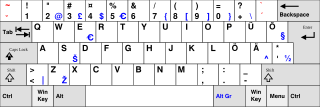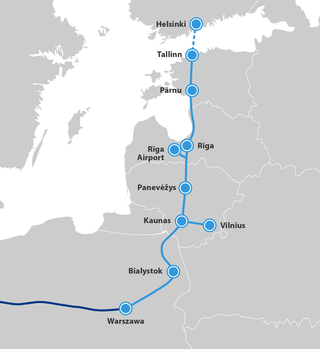
French Sign Language is the sign language of the deaf in France and French-speaking parts of Switzerland. According to Ethnologue, it has 100,000 native signers.

European route E 67 is an E-road running from Prague in the Czech Republic to Estonia and by ferry to Finland. It goes via Prague, Wrocław, Warsaw, Kaunas, Panevėžys, Riga, Tallinn, Helsinki.
Signing Exact English is a system of manual communication that strives to be an exact representation of English language vocabulary and grammar. It is one of a number of such systems in use in English-speaking countries. It is related to Seeing Essential English (SEE-I), a manual sign system created in 1945, based on the morphemes of English words. SEE-II models much of its sign vocabulary from American Sign Language (ASL), but modifies the handshapes used in ASL in order to use the handshape of the first letter of the corresponding English word.

Konstantin Päts was an Estonian statesman and the country's president in 1938–1940. Päts was one of the most influential politicians of the independent democratic Republic of Estonia, and during the two decades prior to World War II he also served five times as the country's prime minister. After the 16–17 June 1940 Soviet invasion and occupation of Estonia, President Päts remained formally in office for over a month, until he was forced to resign, imprisoned by the new Stalinist regime, and deported to the USSR, where he died in 1956.

Võro is the language of South Estonia, belonging to the Finnic branch of the Uralic language family. Governmentally, it has been considered a dialect of the Estonian language along with all varieties of South Estonian. However, many linguists consider South Estonian to be an independent Finnic language. It has its own literary standard and efforts have been undertaken to seek official recognition as an indigenous regional language of Estonia. Võro has roughly 75,000 speakers (Võros), mostly in southeastern Estonia, in the eight parishes of the historical Võru County: Karula, Harglõ, Urvastõ, Rõugõ, Kanepi, Põlva, Räpinä and Vahtsõliina. These parishes are currently centred in Võru and Põlva counties, with parts extending into Valga and Tartu counties. Speakers can also be found in the cities of Tallinn and Tartu and the rest of Estonia.
American Sign Language (ASL), the sign language used by the deaf community throughout most of North America, has a rich vocabulary of terms, which include profanity. Within deaf culture, there is a distinction drawn between signs used to curse versus signs that are used to describe sexual acts. In usage, signs to describe detailed sexual behavior are highly taboo due to their graphic nature. As for the signs themselves, some signs do overlap, but they may also vary according to usage. For example, the sign for "shit" when used to curse is different from the sign for "shit" when used to describe the bodily function or the fecal matter.

The official language of Estonia is Estonian, a Uralic language of the Finnic branch, which is related to Finnish. It is unrelated to the bordering Russian and Latvian languages, both of which are Indo-European.
Gary L. Browning is an American Russian language academic and was the first mission president of the Church of Jesus Christ of Latter-day Saints in Russia, and the Baltic states of Estonia, Latvia, and Lithuania.
The Estonian Rugby Union is the governing body of rugby union in Estonia and was formed in 2007 in response to FIRA-AER expulsion of the Estonian Rugby Federation. In June 2009 the Estonian Rugby Union formally received recognition as the governing body of Rugby Union in Estonia from the Estonian Olympic Committee with permission to represent Estonia at international level.

Rail Baltica is an under-construction rail infrastructure project that is intended to integrate the Baltic states in the European rail network. Its purpose is to provide passenger and freight service between participating countries and improve rail connections between Central and Northern Europe, specifically the area southeast of the Baltic Sea. It is also intended as a catalyst for building the economic corridor in Northeastern Europe. The project envisages a continuous rail link from Tallinn (Estonia) to Warsaw (Poland), consisting of links via Riga (Latvia), Kaunas, and Vilnius (Lithuania). Its total length in the Baltic States is 870 kilometres (540 mi), with 213 kilometres (132 mi) in Estonia, 265 kilometres (165 mi) in Latvia, and 392 kilometres (244 mi) in Lithuania. Rail Baltica is one of the priority projects of the European Union (EU). It is part of the North Sea–Baltic Corridor of the Trans-European Transport Networks (TEN-T).
The Tallinn offensive was a strategic offensive by the Red Army's 2nd Shock and 8th armies and the Baltic Fleet against the German Army Detachment Narwa and Estonian units in mainland Estonia on the Eastern Front of World War II on 17–26 September 1944. Its German counterpart was the abandonment of the Estonian territory in a retreat codenamed Operation Aster.

The Baltic Finnic peoples, often simply referred to as the Finnic peoples, are the peoples inhabiting the Baltic Sea region in Northern and Eastern Europe who speak Finnic languages. They include the Finns, Estonians, Karelians, Veps, Izhorians, Votes, and Livonians. In some cases the Kvens, Ingrians, Tornedalians and speakers of Meänkieli are considered separate from the Finns.
The French Sign Language or Francosign family is a language family of sign languages which includes French Sign Language and American Sign Language.
American Sign Language literature is one of the most important shared cultural experiences in the American deaf community. Literary genres initially developed in residential Deaf institutes, such as American School for the Deaf in Hartford, Connecticut, which is where American Sign Language developed as a language in the early 19th century. There are many genres of ASL literature, such as narratives of personal experience, poetry, cinematographic stories, folktales, translated works, original fiction and stories with handshape constraints. Authors of ASL literature use their body as the text of their work, which is visually read and comprehended by their audience viewers. In the early development of ASL literary genres, the works were generally not analyzed as written texts are, but the increased dissemination of ASL literature on video has led to greater analysis of these genres.

The Estonian Soviet Socialist Republic, Soviet Estonia, or simply Estonia, was a union republic of the Soviet Union (USSR), covering the occupied and annexed territory of Estonia in 1940–1941 and 1944–1991. The Estonian SSR was nominally established to replace the until then independent Republic of Estonia on 21 July 1940, a month after the 16–17 June 1940 Soviet military invasion and occupation of the country during World War II. After the installation of a Stalinist government which, backed by the occupying Soviet Red Army, declared Estonia a Soviet constituency, the Estonian SSR was subsequently incorporated into the Soviet Union as a "union republic" on 6 August 1940. Estonia was occupied by Nazi Germany in 1941, and administered as a part of Reichskommissariat Ostland until it was reconquered by the USSR in 1944.

Estonia, officially the Republic of Estonia, is a country by the Baltic Sea in Northern Europe. It is bordered to the north by the Gulf of Finland across from Finland, to the west by the sea across from Sweden, to the south by Latvia, and to the east by Lake Peipus and Russia. The territory of Estonia consists of the mainland, the larger islands of Saaremaa and Hiiumaa, and over 2,300 other islands and islets on the eastern coast of the Baltic Sea, covering a total area of 45,335 square kilometres (17,504 sq mi). Tallinn, the capital city, and Tartu are the two largest urban areas of the country. The Estonian language is the indigenous and official language of Estonia, and it is the first language of the majority of the country's population of 1.4 million.
Russian Sign Language (RSL) is the sign language used by the Deaf community in Russia, with what is possibly additional presence in Belarus and Tajikistan. It belongs to the French Sign Language family.
Nepalese Sign Language or Nepali Sign Language (Nepali: नेपाली साङ्केतिक भाषा, romanized: Nēpālī Sāṅkētika Bhāṣā is the main sign language of Nepal. It is a partially standardized language based informally on the variety used in Kathmandu, with some input from varieties from Pokhara and elsewhere. As an indigenous sign language, it is not related to oral Nepali. The Nepali Constitution of 2015 specifically mentions the right to have education in Sign Language for the deaf. Likewise, the newly passed Disability Rights Act of 2072 BS defined language to include "spoken and sign languages and other forms of speechless language." in practice it is recognized by the Ministry of Education and the Ministry of Women, Children and Social Welfare, and is used in all schools for the deaf. In addition, there is legislation underway in Nepal which, in line with the UN Convention on the Rights of Persons with Disabilities which Nepal has ratified, should give Nepalese Sign Language equal status with the oral languages of the country.
Latvian Sign Language is a sign language commonly used by deaf people in Latvia. Linguists use LSL as an acronym for Latvian Sign Language.

Mall Nukke is an Estonian artist. A printmaker by training, she is primarily known for her paintings, collages and installations influenced by pop art. Mall Nukke emerged on the Estonian art scene in the early 1990s, her work at the period can be seen as commentary of nascent mass culture and consumer society in newly independent Estonia. Her early collages combined various cultural references and created new media characters based on real entertainers and public figures. Since the 2000s, Mall Nukke has concentrated on creating photo-manipulations and mixed media paintings inspired by Eastern Orthodox icon art.









